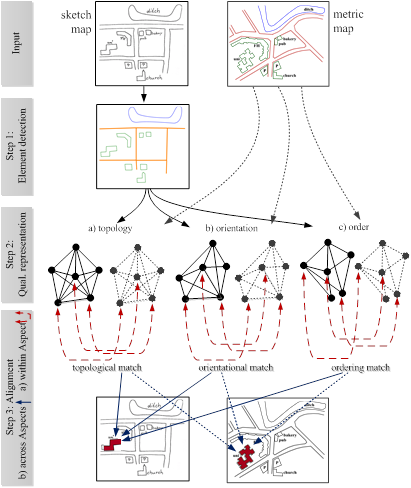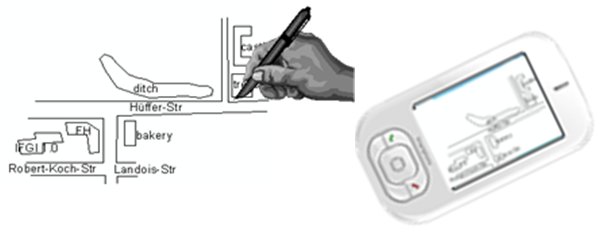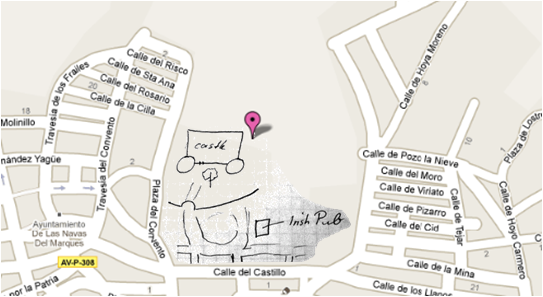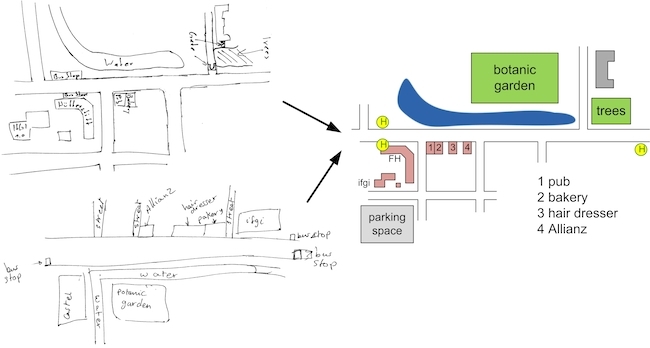SketchMapia Poster: (poster-pdf)
SketchMapia is a system for qualitative mapping of sketch maps and metric maps. The alignment is done in three steps (see Figure 1): First, SketchMapia receives a sketch and a metric map as input. The sketch map is usually drawn on a piece of paper an digitized e.g. by taking a photo of the map. The sketch map is processed to detect spatial objects (street segments, landmarks, junctions) in the sketch map. Step 2 is the qualification of both maps. We compute qualitative descriptions of a set of seven sketch aspects (determined empirically as suitable for alignment) and represent the information in qualitative constraint networks. Step 3 is the alignment of spatial objects in the sketch map to spatial objects in the metric map. At the current state of the SketchMapia development, we align the qualitative constraint networks for each sketch aspect separately and identify a consistent match across sketch aspects after the individual alignment within a sketch aspect was completed.

Figure 1. Overall architecture of SketchMapia.
Input
SketchMapia takes free-hand sketch maps as input. Free-hand sketch maps are drawn on a piece of paper and a mobile phone can be used to take a picture of the sketch map and send it to our sever of SketchMapia (see Figure 2). The recognition and extraction of sketched features as well as the analysis of drawing inaccuracy as overshoots and undershoots are done by computer vision and led by Klaus Broelemann. In this architecture layer, different features of free-hand sketch maps will be detected and classified semantically using the following approaches:
- Object recognition of free-hand sketch maps as input
- vectorization
- object recognition
- text recognition
- domain knowledge modeling

Figure 2. SketchMapia takes free-hand sketch maps as input and they can be pictured and sent by mobile phones.
Processing
The core processing parts of SketchMapia are the alignment and integration of qualitative information from sketch maps and quantitative information from metric maps. Compared to metric maps, relevant information from different aspects is extracted from sketch maps and represented qualitatively, which account for distortions and schematizations from human cognition. Different sketch maps depicting the same area or one sketch map and its corresponding metric map can be aligned on the basis of alignment criteria. Furthermore, based on the alignment, the information in one sketch map can be integrated with information from related sketch maps and metric maps. As the text below shows the main workflow of the processing layer:
- analysis of cognitive errors in sketch maps (led by Jia Wang)
- relevant aspects for alignment of sketch maps and metric maps (led by Jia Wang and Malumbo Chipofya)
- analysis of qualitative representations for the alignment of spatial objects in sketch maps ( led bySahib Jan and Malumbo)
- data integration in one data repository (led by Malumbo Chipofya)
Output
The output of SketchMapia can be textual instructions for guiding a route or visualized in two different ways (see Figure 3a and Figure 3b):

Figure 3a. Integrated visualization of qualitative and quantitative information on a metric map: the sketch map representing an area of a castle and an Irish pub is integrated into a metric map which describes the same area but with more detailed and complete information.

Figure 3b. Integrated visualization of different qualitative information as a schematic map: two sketch maps depicting the same area but both have distortions and schematizations; relevant information is extracted from both sketch maps and integrated as a schematic map. (View full image)


